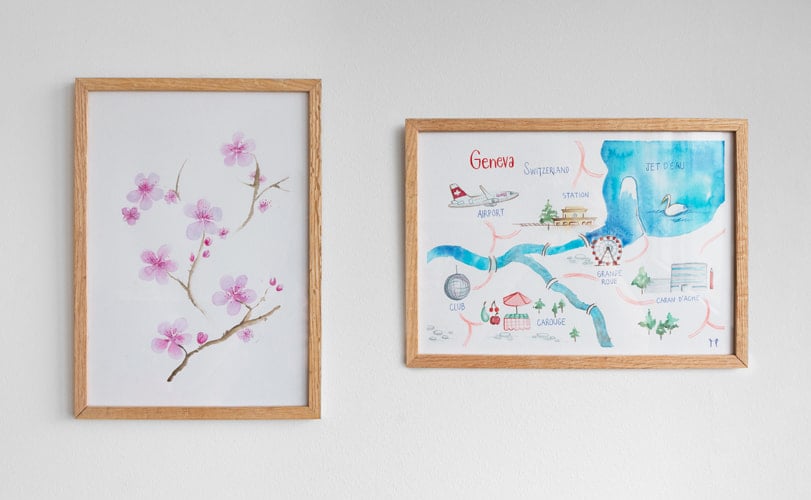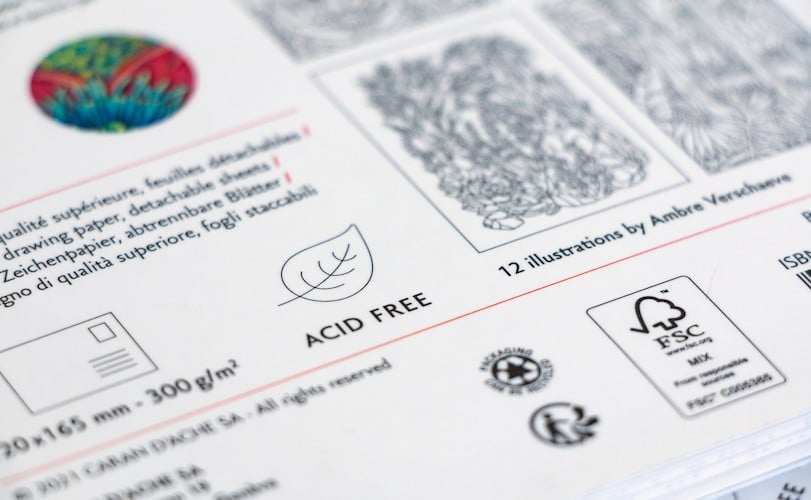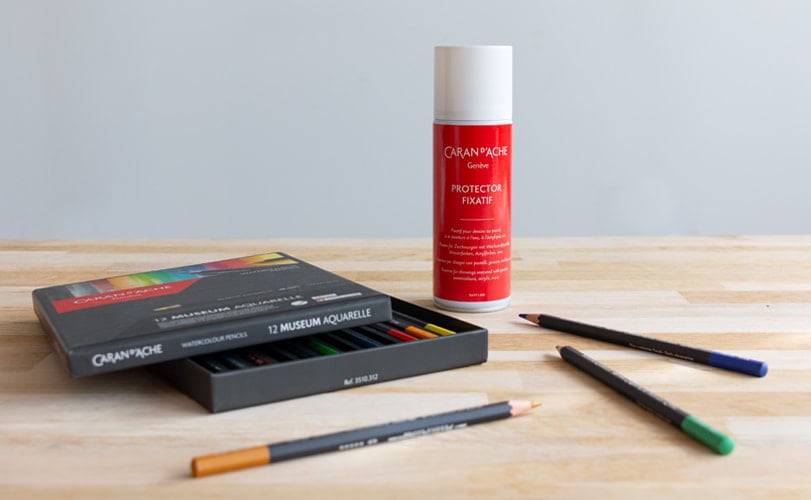Our colour and writing products are manufactured in our workshops in Geneva since 1915.
- FREE ENGRAVING UNTIL MAY 11, 2025 INCLUDED ON OUR HAUTE-ECRITURE COLLECTIONS.
- FREE GIFT WRAP AND PERSONALIZED MESSAGE. FREE DELIVERY ON ORDERS OVER $199.
FRAMING AND PRESERVING YOUR WATERCOLOR PAINTINGS: OUR 5 TIPS
Have you just finished painting your watercolor and are wondering how to frame it? Watercolor paintings are distinct pieces of art that are as vibrant as they are vulnerable, which is why they need special attention to preserve their colors.
Watercolor is both a demanding and inspiring medium, appreciated for its colors and its unique transparency. With Caran d’Ache, learn to take care of your watercolor works. Framing, conservation and the choice of paper: here are all our tips to preserve the beauty and the vividness of your watercolors.
Watercolor is both a demanding and inspiring medium, appreciated for its colors and its unique transparency. With Caran d’Ache, learn to take care of your watercolor works. Framing, conservation and the choice of paper: here are all our tips to preserve the beauty and the vividness of your watercolors.
WHY SHOULD YOU FRAME YOUR WATERCOLORS?
Frame your work to protect it
Because it is so vulnerable, watercolor requires special care and preservation. The pigments can alter under the effect of ultraviolet rays leading to fading or yellowing, while the paper is particularly sensitive to moisture, insects and mold.
Even dry, watercolor is sensitive to water and you risk seeing your colors run or the paper get damaged. Dirt and dust can also affect the delicate surface of these paintings, and the paper can warp or fold if it is not properly manipulated and stored.
Even dry, watercolor is sensitive to water and you risk seeing your colors run or the paper get damaged. Dirt and dust can also affect the delicate surface of these paintings, and the paper can warp or fold if it is not properly manipulated and stored.
Frame your work to preserve colors and vibrancy
Being a water-based paint, watercolor is extremely delicate and fragile. While it is appreciated for its brightness and transparency, watercolor requires special care. At Caran d’Ache, we have developed a wide range of water-soluble media, specially designed so that your work survives the passing of time. Water-soluble felt-tip pens, coloring pencils or even pastels: choose the medium that is best for you.
OUR 5 TIPS FOR FRAMING YOUR WATERCOLORS
1. Frame your watercolor paintings using anti-UV glass
Selecting an anti-UV glass is an excellent way of protecting your work from the effects of ultraviolet rays. Frame your watercolor under UV protection glass or acrylic glass, such as Plexiglass, Acrylite or Perspex, to protect it from direct sunlight.
Choose a frame and UV glass that has been specially designed for the protection of works of art. Different grades of UV protection exist, and generally between 70 and 99% of UV rays are blocked. Make sure you put the glass on a clean and non-abrasive surface. What's more, the glass will act as a barrier against dust and humidity and will protect the painting over time.
Top tip : before framing your watercolor, carefully clean the glass with an adapted cleaner and a cloth. Avoid harsh cleaning products that could damage the UV filter on the glass.
2. Leave a white border around your work using a mat or mount
Not framing your watercolor properly is one of the most common mistakes you can make. It's often the case that people choose a frame that is exactly the right size for the work, but that’s not the best way to showcase or highlight your work. One solution is to opt for a frame that comes with a mat or mount, leaving a space between the frame, the glass and the watercolor. The mat or mount not only highlights the piece of art but will also protect it by preventing direct contact between the glass and the watercolor, thus avoiding condensation and the potential transfer of paint onto the glass.
Top tip : to showcase your watercolor paintings, choose frames with mats or mounts that will bring out the works’ colors and motifs.
3. Choose a high-quality frame that will match the watercolor
As well as looking beautiful, a quality frame will bring strong protection to your watercolor. After checking that the frame fits the size of the watercolor, you should also consider your work’s style and colors.
For modern or contemporary watercolor, a minimalist frame is ideal. In black, wood or metal : choose a frame which complements not only the colors used in your painting, but also the interior decor of the room where it’ll be exhibited.
Top tip : before hanging your framed painting, check that it is well sealed to avoid dust and moisture, watercolors’ two biggest enemies.
4. Use pure-cotton watercolor paper and apply protective varnish
To prevent your watercolor deteriorating or yellowing because of sunlight, use acid-free surfaces and supplies, including the background and the mat.
When it comes to selecting what surface to paint on, you have the choice between paper, card or a watercolor canvas board. Because of its sturdiness, watercolor card is often used for works that need a more stable surface, while paper is the most often used and is adapted to a variety of painting techniques. If you want to explore other media, you can also try a watercolor canvas board.
To protect your finished watercolor painting, seal it with a watercolor protective spray. Many artists appreciate this technique to set their watercolor paintings, and a varnish will preserve the beauty and integrity of your work as well as protect it against potential damage.
When it comes to selecting what surface to paint on, you have the choice between paper, card or a watercolor canvas board. Because of its sturdiness, watercolor card is often used for works that need a more stable surface, while paper is the most often used and is adapted to a variety of painting techniques. If you want to explore other media, you can also try a watercolor canvas board.
To protect your finished watercolor painting, seal it with a watercolor protective spray. Many artists appreciate this technique to set their watercolor paintings, and a varnish will preserve the beauty and integrity of your work as well as protect it against potential damage.
Top tip : whether your paper is fine-grain, rough or has a satin finish, opt for pure-cotton watercolor paper.
5. Keep your watercolor painting in a plastic sleeve
If you don't plan to get your watercolor painting framed or are waiting to find the perfect frame, keep it in a plastic sleeve or folder that's appropriate for storing artwork.
This will help protect your watercolors from dust or moisture which could damage your works’ surface. You'll also be able to travel with your watercolors without friction or folding.
Top tip : choose see-through plastic sleeves specially designed for storing artwork. A transparent folder allows you to know at a glance where you can find each painting.
💡 Are you passionate about watercolor? Learn more about Caran d’Ache water-soluble coloring pencils and discover new techniques to create unique works of watercolor art.
Free from 199$ purchase.
Possible return under 14 days.
Possible return under 14 days.






 Deutschland
Deutschland Austria
Austria Belgium
Belgium Etats-Unis
Etats-Unis France
France Italy
Italy Japan
Japan Netherlands
Netherlands United Kingdom
United Kingdom Switzerland
Switzerland